TL;DR
Some current design trends are destined for quick regret: barn doors on bathrooms, all-gray palettes, open shelving as primary storage, shiplap overload, wet rooms with tubs-in-showers, mega/double islands, gray wood-look floors, and vessel sinks. Try warmer, more timeless interior design styles—think Scandinavian, Japandi, or Quiet Luxury—and preview them in minutes with ReimagineHome.ai using a single photo of your room.
Why Design Trends Matter Right Now
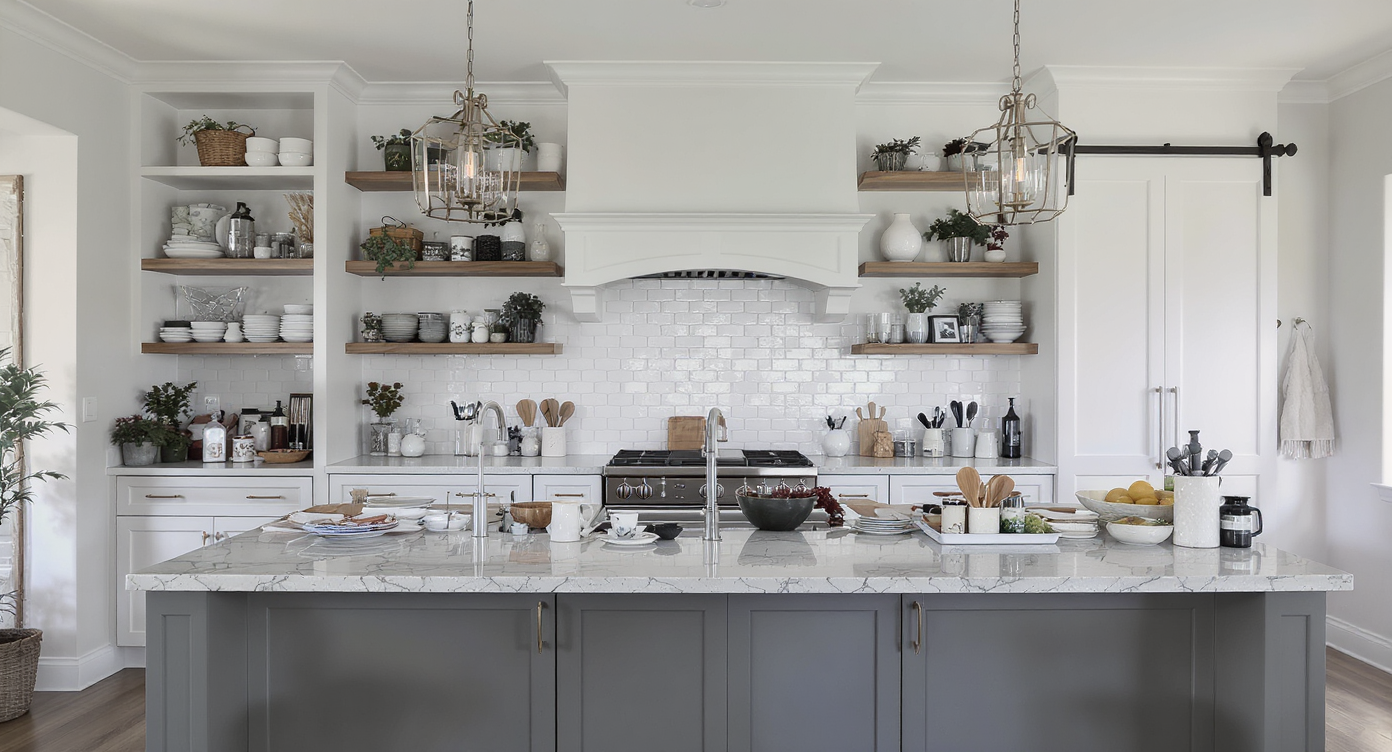
Popular home design trends often sacrifice privacy, maintenance, and ergonomics for style.
Several TV-famous design trends won’t age well: bathroom barn doors, wall-to-wall gray, shiplap everywhere, open shelving as main storage, tubs in showers, double islands, and vessel sinks. They often ignore privacy, maintenance, and ergonomics—leading to noise, dust, chilly bathrooms, and costly do-overs. At a glance - Rethink bathroom barn doors → choose pocket or hinged doors for privacy - Replace all-gray schemes → warm neutrals, layered woods, and color drenching in soft tones - Limit open kitchen shelving → mix closed storage or glass fronts - Skip tubs-inside-showers → separate the soak and steam for comfort and cleaning - Trade double/oversized islands → right-size with 36–42 inch circulation and a real dining table - Avoid gray wood-look floors → natural wood tones or textured stone - Retire vessel sinks → under-mounts at ergonomic height - Use shiplap sparingly → plaster, beadboard, or paneled millwork with restraint Early CTA: See smarter alternatives in your actual rooms. Upload a photo and preview new looks with ReimagineHome.ai: https://www.reimaginehome.ai/?utm_source=blog
What’s Driving These Short-Lived Trends (and the Backlash)
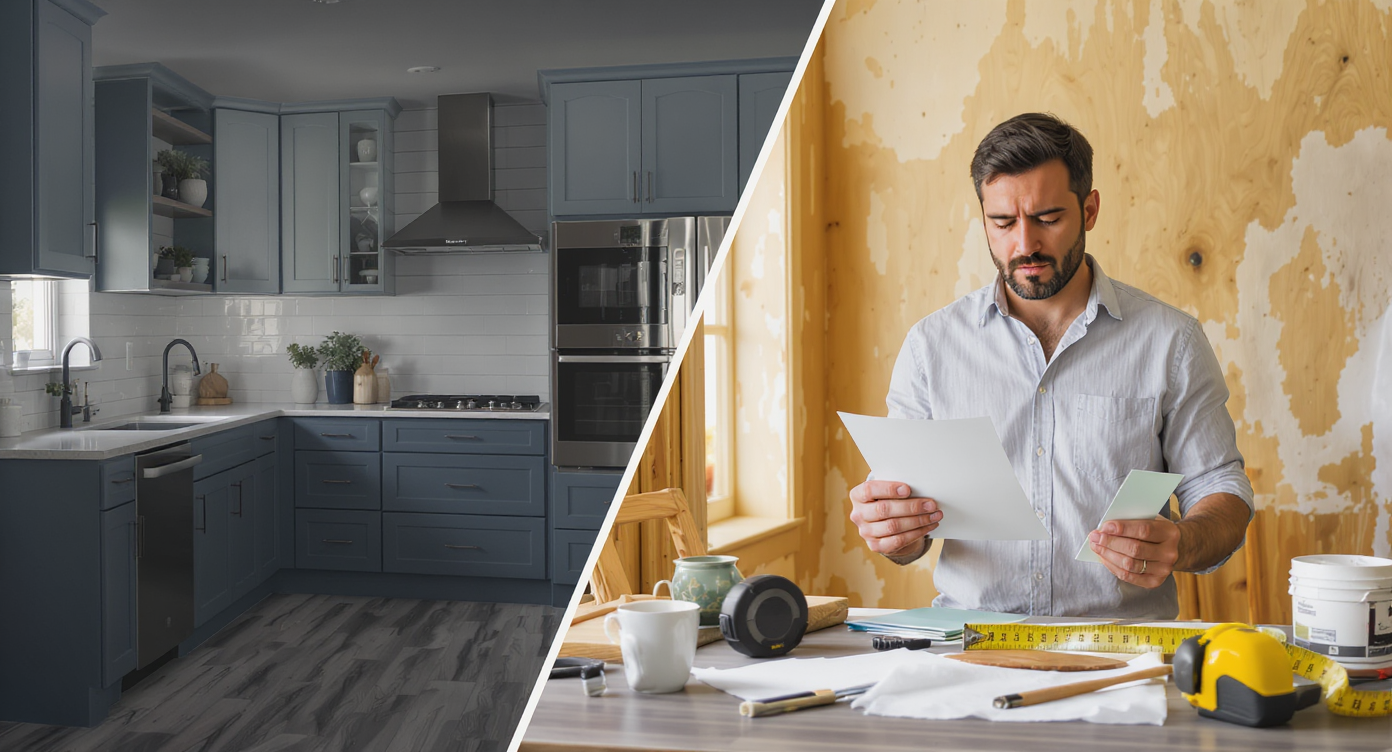
Short-lived styles cause costly fixes—prioritize comfort and ease over fad aesthetics.
Changing paint and hardware often costs hundreds, while replacing floors or countertops can run into the thousands—so future-proofing big moves is worth it. The fast churn of decor content pushes dramatic, photogenic choices that don’t always hold up to daily life. - Barn doors vs. privacy: Sliding barn doors look rustic on TV but rarely seal sound or smells. Bathrooms and bedrooms need closure that latches and blocks gaps. - Open shelving vs. storage reality: One upper cabinet can hold the equivalent of an 18–24 inch run of open shelves, but shelves expose everything to dust and cooking residue. - Shiplap everywhere: What began as farmhouse texture became a default. Overuse flattens character and dates a home to a moment. - Mega/double islands: Showstoppers on camera, but day-to-day they can create long detours, knee-knocking seating, and less space for an actual dining table. - Wet rooms with tubs in showers: They photograph dramatically and cleanly, yet the lived experience is colder, steamier, and harder to maintain. - All-gray palettes and gray floors: Cool grays made spaces read as modern decor, but full-gray schemes can feel flat and “flip house.” Warm neutrals, ecru, and natural wood tones are trending interior design styles for 2025—and age better. Want to compare timeless styles like Scandinavian vs. Japandi in your own room? Start a quick visualization with ReimagineHome.ai: https://www.reimaginehome.ai/?utm_source=blog Or read: Compare Japandi vs Scandinavian at home in minutes (https://www.reimaginehome.ai/blogs/design/japandi-vs-scandinavian) And: Color drenching, softly (https://www.reimaginehome.ai/blogs/trends/color-drenching-guide)
Anecdote
In a 1920s bungalow, a hallway bath had the inevitable barn door. The fix? A solid-core pocket door with soft-close runners and a satin brass pull. Suddenly the room was quieter, warmer, and felt like it belonged to the house again.
How These Looks Actually Live Day-to-Day

Right-sizing and mixing materials creates comfortable, practical living spaces that age well.
Comfortable circulation around a kitchen island needs 36–42 inches; oversized or double islands often break that rule and feel cumbersome. In real homes, function beats spectacle every time. - Bathroom barn doors: Even with soft-close hardware, gaps around the slab mean zero acoustic privacy. A pocket door solves swing clearance without sacrificing dignity. - Open shelving as primary storage: Shelves are great for ceramics and daily glassware, but not for everything. Mix closed lowers and a few uppers with glass fronts to keep dust down while displaying favorites. - Shiplap and random “wood-strip” feature walls: Texture should relate to architecture. If your home isn’t farmhouse, consider limewash, Venetian plaster, beadboard, or simple, flat panels in proportion to the room. - Wet rooms, tub-in-shower: Soaking wants warmth; showers want ventilation. Combining them often makes the tub clammy and hard to clean behind. Separate zones or a freestanding tub with a standard shower feels better. - Gray-on-gray: If you love calm neutrals, shift to warm sand, mushroom, oatmeal, or taupe, then layer textural linens, wool, travertine, and aged brass. A 10–20% hit of color—olive, midnight blue, terracotta—keeps it alive. - Gray wood-look floors: Consider natural oak, hickory, or walnut tones. Even in a minimalist interior design style, a little warmth reads human. - Vessel sinks: Their rims add 4–6 inches of height, pushing many vanities beyond the comfortable 34–36 inch range and splashing more. Under-mounts or integral sinks keep counters wipeable. If you’re debating how to choose an interior design style, upload a photo and audition Scandinavian, Japandi, Soft Boho, and more with AI design tools before you commit.
Modern Tools to Explore Timeless Style (and Why ReimagineHome.ai Wins)

AI tools like ReimagineHome.ai enable fast, inspired exploration of timeless home styles.
AI layout tools can generate style variations in under 10 seconds, and that speed is a game changer for exploring room makeover ideas without risk. - Mood boards and floor planners: Great for inspiration and layout logic, but they’re abstractions. You still have to imagine how materials play in your light. - 3D walkthrough tools: Powerful but time-consuming. You’ll need measurements and modeling skills. - AI virtual staging apps: Useful snapshots, but realism varies and catalogs can be limited. - ReimagineHome.ai: Upload one photo and get realistic, style-specific redesigns—ai interior design from photo that feels true to your architecture and light. It’s a room design AI that suggests furniture, paint color and furniture combos, and decor you can actually live with. Think of it as the most accurate AI interior design app for fast, believable options. Why it wins - Speed: Room transformation AI results in seconds from a single image. - Realism: Shadows, reflections, and scale look right, so it’s easier to judge. - Range: Test trendy ideas safely—then pivot to timeless. Try Japandi, Farmhouse Modern, Minimalist, Maximalist, Industrial, and more. - Guidance: Style recommendation engine helps narrow choices for small spaces or full home design inspiration. Explore more: The best ways to visualize a room makeover from one photo (https://www.reimaginehome.ai/blogs/how-to/visualize-from-one-photo) And: Small apartment layout ideas with AI (https://www.reimaginehome.ai/blogs/small-spaces/layout-ideas)
Step-by-Step — Try a New Style with One Photo in ReimagineHome.ai
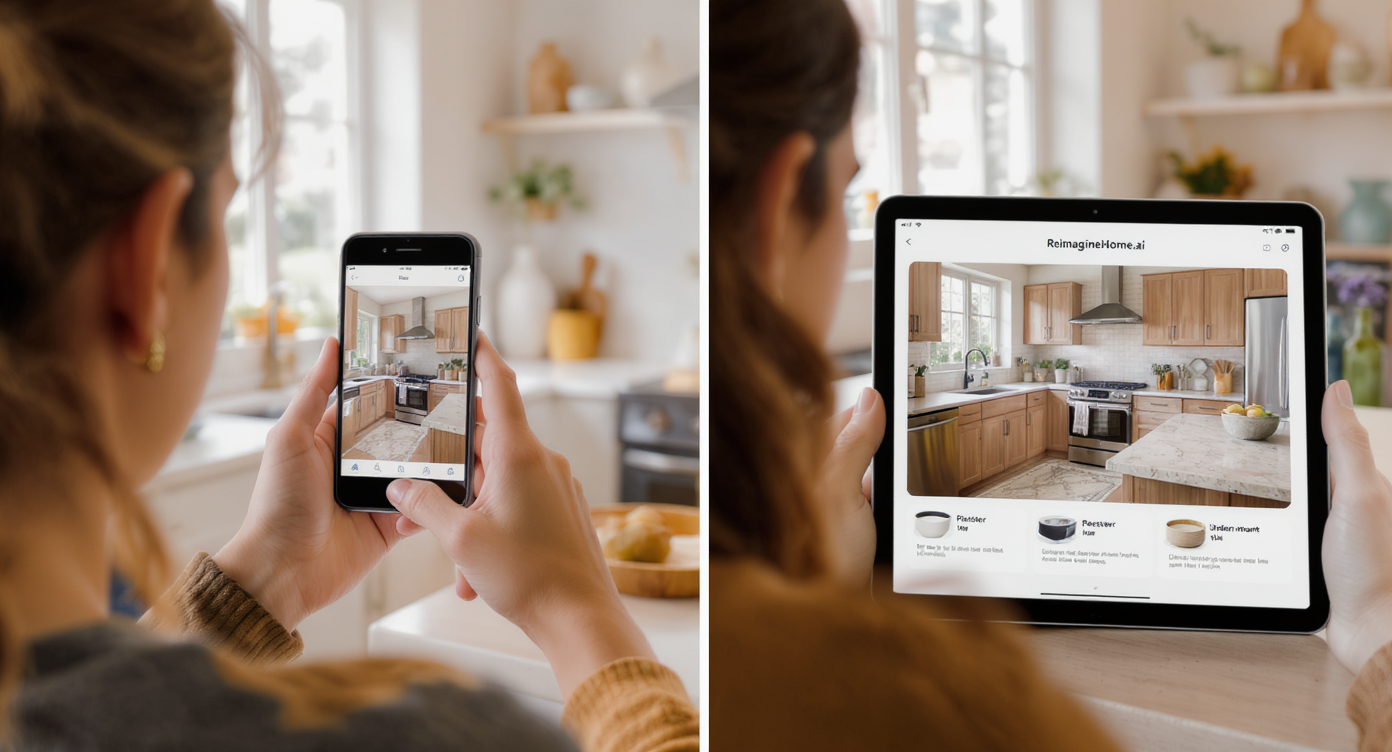
Transform your space swiftly with one photo and AI-powered styling from ReimagineHome.ai.
From photo upload to styled results often takes under a minute—no measurements required. - Step 1: Photograph your space straight-on in daylight. Include the floor and ceiling where possible. - Step 2: Upload to ReimagineHome.ai and pick a direction—Scandinavian calm, Japandi warmth, Soft Boho layers, or Modern classic. - Step 3: Generate 4–8 variations. Toggle materials: swap gray floors for natural oak, trade a bathroom barn door for a pocket door, or replace open shelves with glass-front uppers. - Step 4: Fine-tune. Ask for warmer neutrals, fewer feature walls, or a smaller island with 42 inches of clearance. - Step 5: Save favorites and build a simple mood board. Use it as your contractor brief. Tip: Use the side-by-side compare to judge lighting temperature, texture, and circulation—the everyday details that make a room makeover succeed.
Visualization Scenario
Upload your all-gray living room to ReimagineHome.ai and generate a Japandi re-style: natural oak floors, mushroom walls, a stone coffee table, and linen drapery. Then compare it to a warm minimalist version with plaster-look paint and a slimmer walnut credenza—side by side, in your actual space.
FAQ
Q: How can I visualize a room makeover from one photo? A: Use ReimagineHome.ai. Upload a single image and the AI room decorator produces multiple, realistic redesigns—fabrics, finishes, and furniture—so you can compare options quickly. Q: Are open shelves practical in a small kitchen? A: In moderation. Keep daily cups and bowls on a 1–2 shelf run and rely on closed storage for the rest. If dust bothers you, try glass-front uppers for the display feel without the upkeep. Q: What interior design styles feel timeless for 2025 and beyond? A: Scandinavian, Japandi, and warm Minimalist are strong bets: natural wood, textured stone, quiet color. They adapt well as trends evolve and are easy to refresh with accents. Q: What’s a better alternative to a bathroom barn door? A: A pocket door saves swing space while providing privacy and latchability. If sound is a concern, choose solid-core with soft-close hardware and proper seals. Q: What are the best AI tools for interior style recommendations? A: For speed and realism, ReimagineHome.ai stands out among AI design tools. It offers ai interior design from photo, paint and furniture suggestions, and small apartment layout help without manual modeling.
Visualize Your Style’s Next Chapter
One photo is all you need to preview changes with AI—and that can save you from expensive re-dos later. The interior design style that lasts is the one that favors comfort, privacy, maintenance, and proportion over TV theatrics. Trade bathroom barn doors for pocket doors, limit open shelving, warm up those cool grays, right-size the island, and skip tubs-in-showers and vessel sinks. Then let ReimagineHome.ai show you how it looks in your actual light, with your actual architecture, before you buy a thing. Try it now: https://www.reimaginehome.ai/?utm_source=blog
.svg)

.svg)







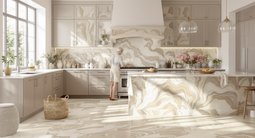



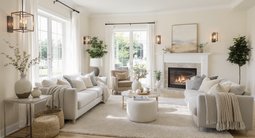


.png)